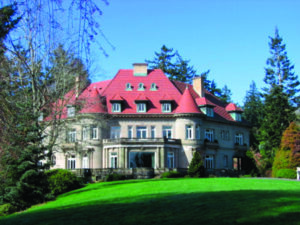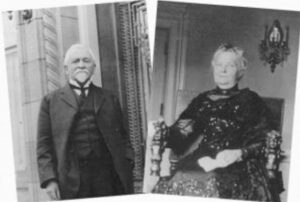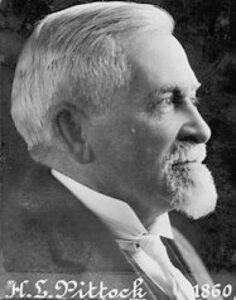

In part one of this series, we read about English-born Henry Lewis Pittock’s journey with a wagon train from Pennsylvania to Oregon in 1853 where, “barefoot and penniless,” he began working for Thomas Dryer’s Weekly Oregonian newspaper.
In 1860, at the age of 26, Henry married 15-year-old Georgiana Martin Burton of Missouri. Six years prior, Georgiana had crossed the plains from Keokuk, Iowa along the Oregon Trail with her parents. Georgiana’s father E.M. Burton was a flour mill owner and one of Portland’s best- known building contractors.
Together, Henry and Georgiana began a long life of work, community service, and devotion to family, which would last 58 years and celebrate six children and eighteen grandchildren.
During the late 1800s and the early 1900s, their lives and work paralleled the growth of Portland from a small northwestern town to a thriving city with a quarter million population.
While Henry was establishing himself as a business leader extraordinaire, Georgiana dedicated herself to improving the lives of the community’s women and children. In 1867, she helped found the Ladies Relief Society whose Children’s’ Home provided care, food, and shelter for needy children. She also worked with the Woman’s Union, and played a major role in establishing the Martha Washington Home for single, working women.

The couple and their five children had been living simply in a small house on a block of land now known as the “Pittock Block” that Henry purchased for $300 in 1856. In managing her household, Georgiana Pittock made use of her frugal pioneer upbringing—for many years she even saved the silver foil in which her tea had come wrapped.
Following a family vacation in Hawaii, Henry stopped off in San Francisco April 18th, 1906 He had arrived at 3 am on a late train from Los Angeles, and found a room at the Occidental Hotel, but was awakened around 5am to “fearful shaking” and “a most hideous din of grinding timbers and ringing bells.”


That day’s destructive San Francisco earthquake gripped the nation and dominated headlines. The Oregonian newspaper had their own exclusive scoop—owner and publisher Henry Pittock had survived the earthquake and its fiery aftermath
Henry and Georgiana were at the pinnacle of their successful lives when they commissioned architect Edward Foulkes to design and build their new home overlooking Portland, the city they loved.
They began planning and designing their home in 1909. The mansion was completed in 1914, replete with stunningly progressive features including a central vacuum system, an elevator, intercoms, and indirect lighting. The house also creatively incorporated Turkish, English, and French designs. In keeping with their loyalty to their home state, the Pittocks hired Oregon craftsmen and artisans, and used local materials to build the house.
Henry had noted how well steel structures withstood the San Francisco earthquake. When building the Mansion he commissioned a house using reinforcing steel in the basement, and fire-resistant materials like concrete. Before the earthquake he also had “never thought that very much of the automobile before,” but was impressed when he saw cars ferrying supplies and the injured, while horses stopped when water ran out and thirst set in.
Remember the silver foil that Georgiana had saved for all those years? When their new mansion was built, she had the foil used to paper the vaulted ceiling of the entryway.
The final estate included the mansion, a three-car garage, a greenhouse, and the Italianate gate lodge servants’ residence, all situated on 46 acres of land almost 1,000 feet above downtown Portland.

At 80 and 68 respectively, Henry and Georgiana moved to their new home. The hard-working couple who had lived in the heart of Portland as it developed from a forest clearing to a bustling business center, now resided high in the hills, with a breathtaking vista of their beloved Portland.
It was a warm and gracious house for both the adults and children of the family. When we toured the mansion a few years ago, the docent pointed to the beautiful shiny marble floors and said that the Pittocks loved to hear their grandchildren laughing as they roller skated through those hallways.
Georgiana, one of the founders of the Portland Rose Festival, died in 1918 at the age of 72, and Henry in 1919 at 84.
The Pittock family remained in residence at the mansion until 1958, until Peter Gantenbein, a Pittock grandson who had been born in the house, put the estate on the market but was unsuccessful in selling it. The mansion was threatened by demolition as a result of extensive damage caused by the Columbus Day Storm in 1962. The community raised $75,000 in three months in order to help the city purchase the property. Seeing this popular support, and recognizing that the house had tremendous value as a unique historic resource, the City of Portland purchased the estate in 1964 for $225,000.
Fifteen months were spent on the restoration. The Pittock Mansion opened to the public in 1965, and has been a community landmark ever since. Each year, approximately 80,000 people visit this Portland treasure, which was added to the National Register of Historic Places in 1974.
In part 3 of this series, we will learn more about the Italianate Gate House that was part of the Pittock Estate.
No Comments
Leave a comment Cancel